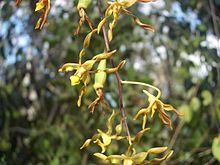- Cepobaculum semifuscum
-
Fragrant Tea Tree Orchid 
Scientific classification Kingdom: Plantae (unranked): Angiosperms (unranked): Monocots Order: Asparagales Family: Orchidaceae Subfamily: Epidendroideae Tribe: Dendrobieae Subtribe: Dendrobiinae Genus: Cepobaculum Species: C. semifuscum Binomial name Cepobaculum semifuscum
(Rchb.f.) M.A.Clem. et D.L.Jones, Orchadian 13(11): 486 (2002).Synonyms - Dendrobium semifuscum
Cepobaculum semifuscum, Antelope Orchid, or Fragrant Tea Tree Orchid, is a species of Tea Tree Orchid of the genus Cepobaculum, which was segregated in 2002 from the genus Dendrobium.[1][2]
Contents
Range
Cape York Peninsula, Queensland from the Iron Range to Cooktown, and on the west coast of the peninsula at 50-550 metres altitude. Also found in New Guinea.[3]
Description
Common and widespread, this arboreal orchid grows especially on paper-barked or rough-barked trees in open forest, swampy areas and monsoonal thickets. The longlasting, sweet-smelling flowers (20-30 x 25-40 mm) bloom from July to November. The fragrant flowers yellowish or yellowish-brown, with darker stripes and tips, grow on spikes 300-400 mm long. Labellum purple to mauve with midlobe which is pale yellow to cream. Sepals strongly twisted, thick and shiny.[4] The flowers appear in spring and last well and the petals are distinctively twisted.[5]
The orchid needs good light. It grows well on a slab and needs a dry winter but frequent watering in summer.
C. semifuscum has, apparently, been frequently confused with Cepobaculum johannis. They are, however, easy to tell apart if flowering: C. semifuscum flowers in the spring while C. johannis flowers in the autumn. The former has a delightful scent, while the latter smells unpleasant.[6]
Footnotes
References
- Beasley, John. (2009). Plants of Cape York: The Compact Guide. John Beasley, Kuranda, Qld., Australia. ISBN 978-0-9806863-0-2.
- Jones, David L. (2006). A Complete Guide to the Native Orchids of Australia Including the Island Territories. Reed New Holland, Sydney. ISBN 1-877069-12-4.
- Scarth-Johnson, Vera (2000). National Treasures: Flowering Plants of Cooktown and Northern Australia. Vera Scarth-Johnson Gallery Association Inc. Cooktown. ISBN 0646397265 (pbk); ISBN 0646397257 (leather bound).
External links
Categories:- Cepobaculum
Wikimedia Foundation. 2010.


